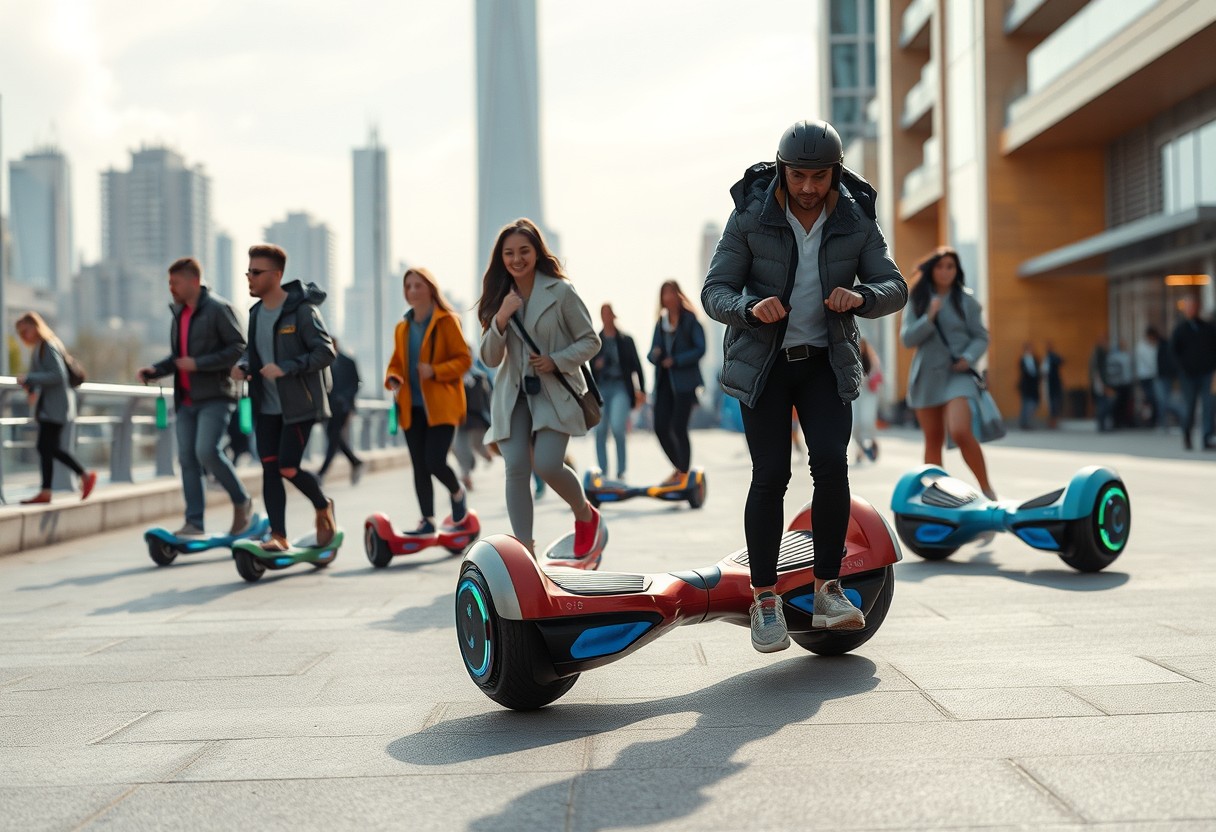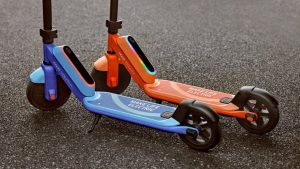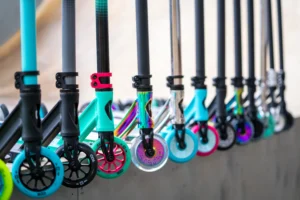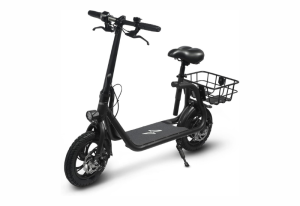With the rapid advancements in technology, you may find yourself wondering how hoverboards will evolve as a viable form of personal transport. As you explore the future of these innovative devices, consider the potential for enhanced safety features, improved battery life, and even faster speeds. However, it’s necessary to stay informed about the regulatory challenges and environmental impacts that may accompany these developments. In this post, we’ll examine into the exciting possibilities that lie ahead for hoverboards and what it means for your commuting experience.
Table of Contents
ToggleThe Evolution of Hoverboards
Before delving into the current state of hoverboards, it’s crucial to understand the historical context that has shaped their development. The idea of personal flying or gliding devices has been a part of science fiction for decades. The concept began taking root in the imagination of people through films, comics, and literature. For instance, the iconic hoverboard featured in the 1989 film “Back to the Future Part II” sparked a fascination that has only intensified over time. Many of you may remember the excitement this sparked, as people dreamt of owning a device that could hover above the ground, imitating the futuristic visions presented on screen.
Historical Context
The first real hoverboards appeared in the early 2010s, when technology began allowing individuals to experience personal transportation in ways previously confined to fiction. Early models were basic at best, functioning more like mini scooters with a balance mechanism than the hovering sensations depicted in movies. As you may recall, these devices started showing up on streets, drawing attention not just for their innovative approach to transport but also for the accompanying safety concerns and issues with quality. This historical evolution signifies a crucial transition from science fiction to commercial reality.
Key Technological Advancements
Evolution in hoverboard technology has been remarkably swift, driven by major advancements in battery life, motor efficiency, and sensors. On the technical front, the emergence of lithium-ion batteries has transformed hoverboards into viable transportation options. These advancements have allowed hoverboards to become more affordable and accessible, improving the overall user experience. You might be aware that greater power translates to higher speeds and longer ranges, which in turn contributes to their appeal among commuters and enthusiasts alike.
Onboard sensors that help with maintaining balance and stability have evolved as well. Modern hoverboards often use gyroscope technology to enhance your riding experience and provide a sense of control that early models lacked. These technical modifications not only ensure that you feel secure while riding but also make the devices more user-friendly for beginners. As technology continues to progress, you can expect even more innovations that may redefine what hoverboards are capable of.
Influence of Pop Culture on Hoverboard Popularity
With the rise of hoverboards, pop culture has played an undeniable role in their popularity. You might not realize how a single film or viral video can catapult a gadget from obscurity into the mainstream. The “Back to the Future” franchise not only romanticized the idea of hoverboards but also created a touchstone moment that influenced various generations. Following the elevation of hoverboards in the limelight, trends such as social media challenges have encouraged more people to give these devices a try, drawing significant attention to their potential
Popularity in pop culture does not just inspire purchase intentions; it has also led to an increase in construction and design options available in the market. When celebrities flaunt their hoverboards or showcase stunts online, this visibility creates high consumer demand and stokes competitive innovation. As you engage with these cultural phenomena, you may find yourself excited about the advances that hoverboards reflect in society.
Current Hoverboard Designs
Assuming you are interested in the latest hoverboard models, you’ll find that current designs have evolved significantly in terms of aesthetics and functionality. The integration of sleek, modern designs with advanced technology has made hoverboards not only a mode of transport but also a style statement. Many hoverboards now feature robust frames, LED lighting, and high-quality finishings that appeal to a wide range of consumers, from tech enthusiasts to casual riders.
Materials and Durability
Current hoverboard designs utilize a variety of materials such as high-density Polypropylene and aluminum alloys to ensure durability and longevity. These materials are chosen for their lightweight properties, which help enhance your riding experience by improving maneuverability. Additionally, the outer casing is often made with scratch-resistant outer shells that withstand the wear and tear of daily use. By opting for a durable model, you can feel confident navigating different terrains without the fear of damaging your device.
The quality of the materials used in construction also directly impacts the hoverboard’s weight capacity and overall performance. Some premium models incorporate carbon fiber to further reduce weight while maintaining strength. This further enhances your riding experience, allowing for faster speeds and easier handling, while also catering to heavier riders who need a reliable and sturdy unit to support their weight comfortably.
Battery Life and Charging Technologies
Battery technology has come a long way in the development of hoverboards, and you will find that many of today’s models are equipped with high-capacity lithium-ion batteries. These batteries are known for their excellent life cycle and can usually last several hours on a single charge, depending on your riding style and the terrain. Charging times vary, with some hoverboards capable of a full charge in as little as 2 hours, making it convenient for you to get back on the road quickly.
Hoverboard manufacturers continuously strive to enhance battery life and the efficiency of charging technologies. Innovations such as smart battery management systems enable better energy consumption, ultimately extending the lifespan of your hoverboard battery. With advancements in this area, you can enjoy a more reliable and enjoyable riding experience without the constant worry of running out of battery power suddenly or experiencing lengthy downtime for recharging.
Safety Features and Regulations
With the rising popularity of hoverboards, safety features have become a focal point in their design. Modern hoverboards are now equipped with a variety of safety mechanisms, including non-slip foot pads, dual braking systems, and LED lights for visibility in low-light conditions, all integrated to enhance your riding safety. Manufacturers also ensure that their products meet certain certification standards, which often require testing to ensure they operate safely under various conditions.
It is crucial to stay informed about the regulations surrounding hoverboard use in your area, as laws can vary significantly. Some cities have specific guidelines about where you can ride and the required safety gear. By being aware of these regulations, you can navigate your riding experience safely and responsibly, ensuring you enjoy all the benefits of hoverboard transportation without the risk of legal troubles.
The Market Landscape
Despite the early challenges faced by hoverboards, the market for these innovative personal transport devices has significantly evolved. The unique appeal of hoverboards has drawn in many consumers, resulting in a competition-rich landscape dominated by several major brands, each striving to capture your attention and offer superior products. This ongoing competition not only encourages brands to innovate but also keeps prices competitive, ensuring that you have access to a variety of options tailored to your needs and preferences.
Major Brands and Competitors
Any discussion about the hoverboard market begins with the key players. Brands like Razor, Swagtron, and Tomoloo have established themselves as leaders in this space, each providing diverse models that cater to different demographics and use cases. These companies invest heavily in technology upgrades, ensuring features like better battery life, enhanced safety protocols, and improved durability—elements that are paramount for you as a consumer looking for a reliable ride.
As the hoverboard landscape continues to mature, new entrants are constantly emerging, seeking to disrupt the market. Startups and smaller manufacturers are exploring unique designs, capabilities, and tailored experiences for niche markets. This influx of competition fuels innovation and provides you with more choices, whether you’re looking for a hoverboard for commuting, recreational use, or even an advanced model equipped with smart technology.
Price Ranges and Consumer Preferences
Price is a crucial factor in the hoverboard market that greatly influences your buying decisions. On one hand, you can find basic models ranging from $100 to $300, which typically serve well for leisurely rides. On the other hand, high-end models—often priced between $500 to $1,000—boast advanced features such as longer battery life, enhanced safety systems, and greater weight capacities. As you navigate through these price points, considering your intended use will help you make a more informed choice.
Plus, consumer preferences have evolved significantly. With an increasing number of users becoming more conscious of safety and quality, many are opting for hoverboards that not only meet basic functionality but also comply with stringent safety standards. This trend pushes brands to ensure that they meet or exceed regulations, providing you with peace of mind as you invest in this personal transport option.
Trends in Consumer Behavior
To understand the future trajectory of the hoverboard market, examining current trends in consumer behavior is important. As more individuals embrace eco-friendly choices, hoverboards are gaining popularity as a sustainable alternative to traditional modes of transportation. Users appreciate the reduced carbon footprint associated with electric hoverboards, aligning their purchases with personal values of sustainability and responsible living.
Understanding this shift, brands are increasingly marketing their products with a focus on the environmental benefits, thereby appealing to your desire for more responsible consumer choices. Additionally, the rise of social media and influencer marketing has led to a surge in hoverboard interest; you may find yourself drawn to models that have been popularized online, altering traditional buying patterns aimed at practicality toward a more holistic lifestyle approach.

Future Technological Innovations
Unlike earlier iterations of hoverboards, the future is poised to bring a myriad of exciting advancements that could revolutionize personal transport. You can explore the possibilities further in an insightful article about the future of electric hoverboards as a mode of personal transportation. These innovations not only promise enhanced performance but also bring the potential for safer, smarter, and more efficient rides.
Enhanced Propulsion Systems
Enhanced propulsion systems are set to be a cornerstone of future hoverboard designs. You may soon see hoverboards equipped with advanced magnetic levitation and ion propulsion technology, allowing for smoother rides and heightened speed capabilities. This next generation of propulsion will likely reduce reliance on traditional battery systems, moving towards lightweight energy storage solutions that can significantly increase the range and efficiency of your hoverboard.
Furthermore, the advent of dynamic thrust vectoring can offer you unprecedented control and maneuverability, making rides not only enjoyable but also safer. As systems become more sophisticated, you can expect hoverboards to self-adjust based on user weight, riding style, and environmental conditions to provide an optimal experience on any surface.
Integration of AI and Smart Features
With the integration of AI and smart features, your hoverboard will become more than just a mode of transportation; it will evolve into a personal companion equipped with various enhancements that can learn your preferences. Imagine a hoverboard that can analyze your riding patterns and adjust its settings accordingly to optimize your comfort and safety while providing real-time data on your speed, distance, and battery life.
A hoverboard that incorporates IoT technology can also connect to your smartphone, allowing you to access navigational assistance and integration with other smart devices. This creates a seamless experience, enabling you to plan your routes effectively while ensuring that you maintain awareness of your surroundings.
Potential for Autonomous Hoverboards
Potential for autonomous hoverboards is an exciting prospect that could redefine personal transport. Imagine a future where your hoverboard can drive you to your destination while you relax or focus on something else. These hoverboards will likely utilize complex sensors and systems like LIDAR, GPS, and AI, allowing them to operate independently in various environments while avoiding obstacles.
Another major benefit of autonomous hoverboards is their potential to reduce accidents and increase pedestrian safety. The integration of advanced collision detection systems can ensure that your hoverboard navigates through crowded areas with ease, prioritizing the safety of pedestrians and other users. As technology progresses, the reality of a fully autonomous hoverboard may not be as far off as you might think, inviting new opportunities for urban mobility and reshaping the landscape of personal transport.
Environmental Impact
Keep in mind that as hoverboards continue to revolutionize personal transportation, their environmental impact becomes a critical consideration. You need to be informed about how hoverboards can align with sustainability goals, ultimately contributing to a more eco-friendly transportation ecosystem. Understanding how hoverboards are manufactured and what materials are used will help you make more conscious decisions when choosing your mode of transport. By focusing on reducing environmental footprints, the hoverboard industry presents an opportunity to innovate responsibly.
Sustainability in Manufacturing
For the hoverboard manufacturers to reduce their environmental impact, sustainability in manufacturing must be prioritized. This involves sourcing materials like recycled plastics and metals to construct hoverboards, ensuring that the overall ecological footprint is minimized. By utilizing environmentally-friendly materials, manufacturers can help decrease the demand for virgin resources, which is crucial in conserving natural habitats and reducing waste in landfills.
Additionally, adopting sustainable production practices, such as decreased energy consumption and implementing waste reduction strategies, can significantly enhance the overall sustainability of hoverboard manufacturing. As a consumer, you can support companies that prioritize these practices, knowing that your purchase contributes to a greener future.
Energy Efficiency Improvements
The evolution of hoverboards has led to ongoing advancements in energy efficiency, which is crucial for a sustainable future in personal transportation. Innovations in battery technology, such as lithium-ion batteries with longer lifespans and faster charging capabilities, can greatly reduce the overall environmental impact of hoverboards. When hoverboards consume less energy during operation, not only is the carbon footprint reduced, but it also enhances your riding experience, allowing for longer rides between charges.
Sustainability is further bolstered by smart energy management systems integrated into newer hoverboard models. These systems optimize power consumption based on riding conditions and rider behavior, ensuring that your hoverboard runs at peak efficiency. As you select a hoverboard, consider how energy-efficient features can benefit both your rides and the environment.
Life Cycle Assessment of Hoverboards
Manufacturing hoverboards involves several stages, each contributing to their overall environmental impact. A comprehensive life cycle assessment (LCA) evaluates the environmental effects from the extraction of raw materials to production, use, and eventual disposal. By understanding the LCA, you can gain valuable insights into the hoverboard’s impact on the ecosystem and make informed choices about maintenance and disposal practices to minimize harm.
Notably, the LCA helps identify areas for improvement within the hoverboard industry. Incorporating more sustainable practices throughout the production chain, from material sourcing to energy use, allows manufacturers to adopt solutions that lower the overall environmental footprint. When choosing your hoverboard, being critical of the manufacturer’s sustainability efforts can go a long way in supporting eco-friendly practices.
Impactful changes in hoverboard production and use practices could lead to a significant reduction in carbon emissions and pollution over time. By choosing brands that emphasize honest transparency regarding their life cycle assessments, you can ensure that your hoverboard is more than just a mode of transport; it represents a commitment to preserving the planet for future generations.
Societal Implications
Changes in Urban Mobility
An increase in the use of hoverboards is poised to significantly alter how you navigate urban environments. As these personal transport devices become more integrated into daily life, traditional modes of transport such as cars and buses may see a decline in usage. This shift can lead to enhanced mobility within crowded city spaces, allowing you to bypass traffic congestion and reduce the time spent commuting. Moreover, hoverboards can enhance last-mile connectivity, making it easier for you to travel from public transit stops to your final destinations without the hassle of parking.
Furthermore, the incorporation of hoverboards into your everyday travel routine can foster a more sustainable urban ecosystem. With fewer emissions compared to gas-powered vehicles, hoverboards contribute positively to air quality in cities. This shift toward cleaner personal transport options can lead to a decline in urban traffic and a rise in pedestrian-friendly spaces, encouraging both your engagement with the community and healthier lifestyle choices.
Impact on Traffic and Infrastructure
For cities to effectively accommodate the rising popularity of hoverboards, significant changes in traffic management and infrastructure will be vital. As hoverboards gain traction as a common means of transport, city planners must rethink road design, implementing dedicated lanes for personal transport devices to ensure safety for all commuters. This will necessitate an investment in new infrastructure, which could improve your overall travel experience while minimizing accidents between hoverboards and other vehicles or pedestrians.
Additionally, the introduction of smart technologies, such as integrated traffic signals and tracking systems for personal transport devices, could further enhance your travel experience. By providing real-time data on traffic conditions and the availability of hoverboard lanes, these innovations can help you navigate your city more effectively and make more informed decisions on when and where to travel. As hoverboards become mainstream, the potential for urban areas to transform into smoother, safer environments for personal transport becomes more plausible.
Mobility challenges also arise as hoverboards demand a new approach to infrastructure. With more personal transport devices on the road, existing traffic regulations may need adjustments to ensure adequate protection for hoverboard users. This could include implementing speed limits specifically for hoverboards, establishing rules for where they can be operated, and introducing mandatory safety measures such as helmets and protective gear.
Legal and Regulatory Challenges
With the rise of hoverboards, you may encounter various legal and regulatory challenges that can impact your right to use them. Different regions may have contrasting laws regarding where hoverboards are permitted, along with age restrictions and licensing requirements. This variation can lead to confusion about the rules, leaving you to navigate a complex legal landscape. As hoverboards evolve and technology improves, lawmakers will need to work diligently to keep regulations up to date and relevant.
Additionally, the absence of standardized regulations can result in inconsistent enforcement and safety concerns for you and others. For example, in some areas, you may find hoverboards forbidden on sidewalks or roadways, limiting your ability to travel efficiently. Until a clear framework emerges, this landscape will remain muddied, and you may be left to grapple with the consequences of ambiguous legalities.
Traffic regulations will be crucial in shaping the future of hoverboard acceptance. As more individuals adopt hoverboards, municipalities must develop comprehensive guidelines that address safety, rights-of-way, and liability. You may find that local ordinances evolve quickly, aiming to accommodate the growing popularity of hoverboards while also prioritizing public safety. It is vital for you to stay informed about these changes as hoverboarding becomes a more mainstream and integral part of your urban landscape.
Final Words
On the whole, the future of hoverboards promises to be an exciting landscape for personal transport innovation. As you look ahead, consider how advancements in battery technology, materials science, and smart features will shape your experience. With increasing emphasis on sustainability, future hoverboards are likely to become more eco-friendly, offering you a greener alternative for short commutes. Innovations such as enhanced safety mechanisms, autonomous navigational capabilities, and seamless integration with smart city infrastructure will elevate not just your travel experience but also contribute to a more efficient urban mobility ecosystem.
As you stay informed about the latest developments, remember that the personal transport sector is continually evolving. By embracing emerging technologies and designs, you can be part of a transformative journey in how we move around. Whether it’s futuristic hoverboards equipped with artificial intelligence or advanced propulsion systems, the possibilities are endless. Allow your curiosity to guide you through this dynamic field, and you may find that the hoverboard of your dreams—and a more efficient personal transportation experience—is just around the corner.
FAQ
Q: What technological advancements are expected to improve hoverboards in the future?
A: Future hoverboards are anticipated to incorporate advancements such as enhanced battery technology, allowing for longer rides and quicker charging times. Developments in propulsion systems, such as electromagnetic propulsion and improved gyroscopic stability, will also contribute to better maneuverability and safety. Additionally, integrating AI for navigation and obstacle detection could enhance user experience and safety in crowded environments.
Q: Will hoverboards be legal to use on public roads and sidewalks?
A: The future legality of hoverboards on public roads and sidewalks will largely depend on local regulations and safety standards. As hoverboard technology progresses, it is likely that more cities and countries will adapt or create laws to govern their use. Advocates for personal mobility devices are pushing for regulations that ensure safety for both riders and pedestrians, which could lead to more acceptance in public spaces.
Q: How will hoverboards address environmental concerns?
A: The future of hoverboards is expected to focus on sustainability, utilizing eco-friendly materials and energy sources. Electric hoverboards will likely feature renewable energy options and be designed for lower power consumption. Additionally, manufacturers may increase their efforts in producing recyclable components, reducing the overall carbon footprint associated with personal transportation.
Q: What safety features could be implemented in future hoverboard designs?
A: Future hoverboards are likely to come equipped with advanced safety features including integrated lighting for visibility, automatic braking systems, and better shock absorption. Innovations such as built-in helmets or protective gear that can be contained within the hoverboard design, as well as smart technology that alerts users on potential hazards, will be crucial in promoting safer riding experiences.
Q: How might hoverboards integrate with other modes of transportation in urban areas?
A: In the future, hoverboards may play a key role in multi-modal transportation systems within urban environments. They could be designed to easily connect with public transit options, such as buses or trains, allowing for seamless transitions between traffic. Additionally, smart city initiatives may accommodate hoverboards through dedicated lanes or docking stations, promoting their use as a viable alternative for short-distance travel in conjunction with other forms of transport.







